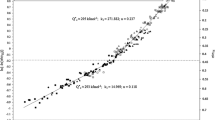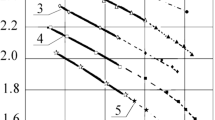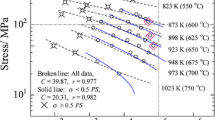Abstract
The method of basic diagrams was used to analyze over 200 creep-rupture diagrams obtained in long-term experiments (100,000 h or more). The analysis of known experimental data and the prediction of creep rupture based on the departure of some portions of experimental diagrams from the corresponding protions of basic ones offers strong possibilities for increasing the accuracy and reliability of predictions.
Similar content being viewed by others
References
R. M. Goldhoff, “Towards the standardization of time-temperature parameter usage in elevated temperature data analysis”,J. Test. Eval.,2, No. 5, 378–424 (1974).
S. S. Manson and C. R. Ensign, “A quarter-century of progress in the development of correlation and extrapolation methods for creep-rupture data”,J. Eng. Mater. Technol.,101, 317–324 (1979).
Yu. N. Rabotnov,Creep of Structural Elements, [in Russian], Nauka, Moscow (1966).
J. B. Conway, and P. N. Flagella,Creep-Rupture Data for Refractory Metal to High Temperatures, Gordon and Breach, New York-London-Paris (1971).
A. L. Arshakuni, A. M. Lokoshchenko, V. N. Kiselevskii et al., in: S. A. Shesterikov (Ed.),Relationships of Creep and Long-Term Strength, Handbook [in Russian], Mashinostroenie, Moscow (1983).
S. A. Shesterikov and A. M. Lokoschenko, “Creep and long-term strength of metals”, in:Science and Technology Results, Mechanics of Deformable Solids [in Russian], Vol. 13, VINITI, Moscow (1980), pp. 3–104.
R. R. Larson and J. Miller, “Time-temperature relationship for rupture creep stress”,Trans. ASME.,74, No. 5, 765–775 (1952).
S. S. Manson and A. M. Haferd, “A linear time-temperature relation for extrapolation of creep and stress rupture data”,NASA TN TN, 2890 (1953).
R. I. Orr, O. D. Sherby, and J. E. Dorn, “Correlation of rupture data for, metals at elevated temperatures”,Trans. ASM.,46, 113–128 (1954).
“Data sheets on the elevated-temperature properties of 1Cr-0.5Mo steel”,NRIM Creep Data Sheet, No. 35A (1990).
“Data sheets on the elevated-temperature properties of 1Cr-1Mo-0.25V steel”,NRIM Creep Data Sheet, No. 9B (1990).
“Data sheets on the elevated-temperature properties of 18Cr-8NiTi stainless steel”,NRIM Creep Data Sheet, No. 5B (1987).
“Data sheets on the elevated-temperature properties of 12Cr steel”,NRIM Creep Data Sheet, No. 13A (1987).
V. V. Krivenyuk,Prediction of Long-Term Strength of Refractory Metals and Alloys, [in Russian], Naukova Dumka, Kiev (1990).
G. S. Pisarenko and V. V. Krivenyuk, “New approach to the prediction of long-term strength of metals”,Dokl. AN SSSR, Mekh.,312, No. 3, 558–562 (1990).
V. V. Krivenyuk and D. R. Sklyarevsky, “Specific features of prediction of long-term strength characteristics of metallic materials at a useful life of over 100,000 h”,Probl. Prochn., No. 12, 37–42 (1994).
“Data sheets on the elevated-temperature properties of 2.25Cr-1Mo steel”,NRIM Creep Data Sheet, No. 3B (1986).
H. J. Frost and M. F. Ashby,Deformation Mechanism Maps, Pergamon Press, Oxford (1982).
A. Ya. Krasovskii, L. Toth, “Thermodynamic nature of empiric exponential relations of strength and fracture characteristics of materials with time. Pt 1. Creep and long-term strength”Probl. Prochn., No. 2, 5–24 (1996).
K. Miller “Creep and fracture”, in: Proc. Intern. School of Physics “Enrico Fermi” (Mechanical and Thermal Behavior of Metallic Materials), North-Holland, Amsterdam (1982).
V. I. Kovpak,Prediction of High-Temperature, Strength of Metallic Materials [in Russian], Naukova Dumka, Kiev (1981).
H. Diehl, Jü. Granacher, and Jo. Granacher, “Ergebnisse aus Zeitstandversuchen bei 500°C mit einer Beanspruchungsdauer bis über 300,000 h”,Archiv für das Eisenhüttenwesen, No. 7, 299–303 (1979).
S. A. Shesterikov and A. M. Lokoshchenko, “Effect of stress concentrations of long-term strength”,Probl. Prochn., No. 5, 39–43 (1996).
Additional information
Deceased
Institute of Problems of Strength, National Academy of Sciences of Ukraine, Kiev, Ukraine. Translated from Problemy Prochnosti, No. 3, pp. 24–36, May–June, 2000
Rights and permissions
About this article
Cite this article
Krivenyuk, V.V., Zaslotskaya, L.A. & Avramenko, D.S. Some features and potentialities of the generalized analysis of creep-rupture data for metallic materials. Strength Mater 32, 225–233 (2000). https://doi.org/10.1007/BF02509849
Received:
Issue Date:
DOI: https://doi.org/10.1007/BF02509849




